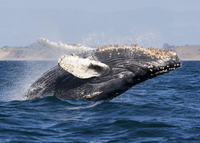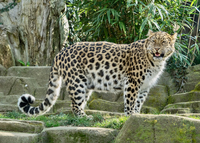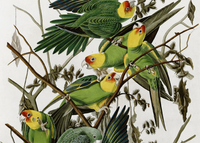The living beings of Planet Earth—from animals to plants to humans—are all critical parts of our global ecosphere, and a risk to any species poses a risk to us all
It's essential to keep our ecosystems in check so that future generations can enjoy the natural world as we know it. Leading global organizations like the World Wildlife Fund (WWF) and the International Union for Conservation of Nature (IUCN) are working hard in their conservation efforts to preserve the planet's populations, and we must each do our part in any way that we can.
The Earth's species are under massive threat. According to IUCN, more than 41,000 species are at risk of extinction, which is 28 percent of all assessed species. There are currently more plants and animals than ever on the global list of threatened species, and while it is extremely difficult to identify the exact number of species that are going extinct, WWF estimates the rapid loss of species today to be between 1,000 and 10,000 times higher than the natural extinction rate. This means that there are more than natural forces at play—with almost the sole responsibility falling on us humans. WWF Germany has shared that more than 1 million species could go extinct over the next decades—which would be the largest mass extinction event since the end of the dinosaur age.
"Species conservation is no longer just about defeating an environmental problem, but is rather about the question of whether or not humanity will eventually end up on the Red List in an endangered category—and thereby become a victim of its own lifestyle," said WWF Germany director Eberhard Brandes.
The biggest drivers of biodiversity loss include overfishing, pollution, climate change and habitat loss. These actions all have consequences on those who live here, with warmer temperatures causing animals to find new areas to survive and thrive, flowers to bloom earlier, migratory birds to return earlier, and the list goes on. Human actions are putting pressure on each part of the ecosystem, and the rest are left to suffer the consequences.
The IUCN Red List of Threatened Species keeps a comprehensive global inventory of the global conservation status of animal, fungi and plant species. It is a gauge of the world’s biodiversity and is a critical resource to incite action toward conservation. The list includes information about the range, population size, habitat and ecology, use and/or trade, threats, and conservation actions that will help protect and preserve the species that call this planet home.
Now let’s take a closer look at where some key species stand on conservation status lists in Environment 911's list of The Good, The Bad, and The Extinct...
The Good: Species seeing a comeback Photo by Mike Doherty on Unsplash
Photo by Mike Doherty on Unsplash
Conservationists are working hard to protect animals and recover them from the endangered species list, and there are encouraging success stories to be shared. Here are some wildlife species that are making a comeback.
Humpback whales (pictured above) have been under threat due to fishing bycatch, ship collisions, and the commercial whale industry, but they are now recovering in numbers in several oceans. A report says that in Australia, humpback whale populations are replenishing along the East and the West Coast. Commercial whaling was banned in 1986, and the report says humpback whale populations are now 50 percent higher than their pre-whaling numbers.
The south-western black rhino’s population increased by 11 percent between 2012 and 2017 and in March 2020, was reclassified from “vulnerable” to “near-threatened” on the IUCN’s list. The population has been steadily climbing since 2012, despite persistent poaching threats. With one-third of Africa’s black rhinos found in Namibia, the improvement is attributed to increases in game guards, monitoring efforts, community engagement campaigns and translocation projects.
Atlantic bluefin tuna, which is sought after for sushi and valued at thousands of dollars, recently jumped three categories on IUCN's Red List for Threatened Species from “endangered” to “least concern” on the list. The Southern bluefin climbed from “critically endangered” to “endangered”, and albacore and yellowfin tuna were “least concern” in the latest report.
While tigers are still classified as endangered on the IUCN Red List, the most recent assessment indicates that there are 40 percent more tigers accounted for since the last count in 2015. This is largely due to improvements in monitoring. Conservation efforts are still necessary due to major threats including poaching of tigers and their prey and habitat fragmentation due to agriculture and human settlement.
Other wildlife species that are making a comeback around the globe include the black-footed ferrets in the Northern Great Plains; the greater one-horned rhino in India; mountain gorillas in Uganda and the Democratic Republic of the Congo; snow leopards in Mongolia, and swift foxes in Montana. Find more success stories on WWF’s website.
The Bad: Species threatened by extinction William Warby, CC BY 2.0 via Wikimedia Commons
William Warby, CC BY 2.0 via Wikimedia Commons
Human action has led tens of thousands of species to the threat of extinction, and conservation action is necessary to keep them on the planet. Here are some animals that are threatened by extinction and on the endangered species list.
The Amur leopard (pictured above), found in the far east of Russia and northeastern China, is probably the rarest big cat on the planet. They have been critically endangered since 1996 and were even pushed to the verge of extinction at the end of the last century when only 30 individuals were estimated to remain in the wild. They face multiple threats such as habitat loss, prey scarcity and transportation infrastructure. WWF shares that there is hope, as their range has expanded three-fold in just over 20 years, though there are still only around 100 individuals in the wild.
A recent IUCN Red List report shows that the migratory monarch butterfly was added to the list of endangered species. The beautiful butterfly is known for its annual migration of up to 4,000 kilometres across the Americas, but its species is threatened by habitat destruction and climate change, including drought, wildfires, temperature extremes, and other severe weather conditions triggering earlier migrations before their host plant, milkweed, is available.
The global sturgeon assessment, of which there are 26 remaining species, is now 100 percent at risk of extinction, up from 85 percent in 2009. Sturgeons have been overfished for their meat and caviar, and their reproduction has been affected by warmer rivers due to rising temperatures.
Other endangered species include Javan rhinos, the Tundra Island tiger, Tapanuli orangutan, Yangtze Finless Porpoise, black rhinos, African forest elephant, Sumatran orangutan, and Hawksbill turtles. Read more here via WWF and view the full list of all the IUCN’s Critically Endangered or Endangered species here.
The Extinct: Species that have disappeared John James Audubon, Public domain, via Wikimedia Commons
John James Audubon, Public domain, via Wikimedia Commons
Unfortunately, some species have been unable to survive human and environmental pressures. Here are some wildlife species that have sadly been classified as extinct.
Once relatively common from the Carolinas through the southeast USA to Texas, the ivory-billed woodpecker was last recorded to be seen in 1944 and has since been declared extinct by the US government. Its numbers declined due to the demand for lumber after the American civil war leading to the destruction of its habitat and its primary food source, beetle larvae. But controversy has been sparked as some researchers claim to have spotted the bird and heard its call, so perhaps there is still hope for a comeback.
Once thought to be the most abundant bird in the world with a population of billions, Passenger pigeons declined to become extinct within just a 50-year period. While there is much speculation about the cause of this abrupt and massive drop in numbers, researchers believe that this species suffered from both human hunting and their own biology, which was unable to survive natural selection.
Commonly known as a Tasmanian tiger, the last known Thylacine passed away in captivity in 1936. Resembling a dog, this marsupial could only be found on the island of Tasmania, and as it began attacking European settlers’ sheep it was eradicated, already extremely rare by the 1920s before ultimately going extinct.
The only indigenous parrot in North America, the Carolina parakeet (pictured above) was last sighted in the early 1900s. This bird suffered multiple threats: its forest habitat was cleared in the 1800s, and farmers began to exterminate the birds in fields and orchards as they were viewed as agricultural pests. They were also hunted for their colourful feathers, which were used to decorate women’s hats.
While many animals have fallen victim to extinction, hopefully, we can learn from these circumstances to protect existing species. Learn about other species that have gone extinct here.
So what can we do to help endangered species? WWF
WWF
We have a responsibility to protect all life on Planet Earth in any way that we can. Actions include combatting climate change; nurturing, protecting, and restoring species and their habitats; advocating against animal cruelty and activities that destroy the environment; pushing for policies that protect wildlife and their habitats; supporting sustainable fishing, and more. WWF and IUCN provide many ways to get involved, like adopt an animal and donation programs.
We can also do our part to protect natural spaces by volunteering at nature centres or wildlife refuges, researching to make sure we are supporting ethical companies, and spending time educating ourselves and others about the unique species and what they need to thrive.
We must respect wildlife in ways such as abiding by restrictions in outdoor spaces; never leaving a trace; avoiding spreading non-native or invasive species; avoiding herbicides and pesticides and opting for organic ingredients; using wildlife-friendly materials; and recycling and buying sustainable products.
Every one of Planet Earth's species has a role to play in our global ecosystem and must be protected, or extinction will become a severe reality for many.




